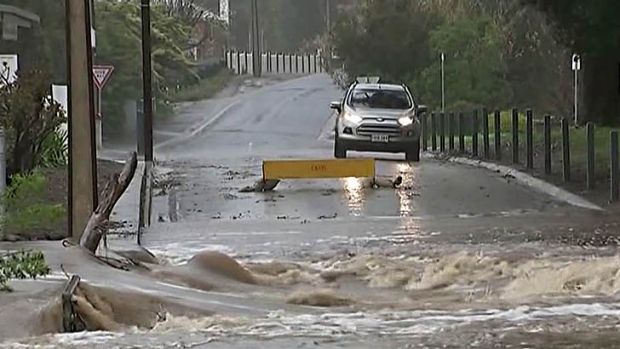After a week of storms, flooding and tornadoes, the south-east of the country will be hit by another cold front on Sunday night.
An incredible ring-like low-pressure system has been lashing southern and eastern parts of Australia since Wednesday, pushing unprecedented winds up into South Australia and across to NSW, Victoria and Tasmania.
More News Videos
Severe weather continues in South Australia
Wild weather is causing another round of blackouts and evacuations. Emergency warnings have been issued and 12,000 homes are still without power. Vision courtesy ABC News 24
Five people, including two young children, escaped fast-flowing rising floodwaters in Tasmania on Friday after the island state copped widespread torrential rain.
South Australia was pummelled by a once-in-50-year weather event with tornadoes, large hail, flash flooding and a statewide blackout on Wednesday.

By Friday, the complex weather system had moved away, leaving a a big clean-up bill in its wake.
Victorians escaped the worst of the cyclonic weather this week and despite some rain to hit Melbourne on Saturday morning, by the AFL grand final bounce at the MCG, those showers will have cleared.
"All of the game is looking dry at this stage, if there's any rainfall during the grand final it will be very light and brief and it won't have any significant impact on play," Weatherzone meteorologist Ben Domensino said.
The ring-like storm phenomenon that hit South Australia is called a cut-off system, a low-pressure system that breaks away from the main flow of westerly winds that lie south of Australia.

"It's unusual for it to be this well organised and this well developed in Australia," Weatherzone meteorologist Rob Sharp said.
"It wraps all the way around with the associated cold front and the trough that continues up into Queensland. We often see cut-off low pressure systems but it's rare for them to be as slow moving as this one and as powerful as this one."
Mr Sharp said South Australia had suffered the double-whammy of a summer-like thunderstorm on Wednesday, with more than 100,000 lightning strikes, and then a winter-like storm on Thursday with cold temperatures and huge winds.
"In a sense, South Australia got the worst of the summer [storms] followed by one of the worst of winter storms this year," he said.
Parts of sodden north-east Victoria received up to 50mm of rain on Thursday morning, spurring a number of moderate and minor flood warnings.
Mount Hotham recorded 145km/h winds.
Victoria's alpine areas were even spoilt with white powder, with between 20 and 30cm of snow covering the peaks on Thursday.
Tasmania also suffered from heavy flooding on Friday.
Just after midday on Friday, a rescue helicopter was called to Huonville, south of Hobart, where the group of family and friends was trapped in a boat as they tried to reach higher ground.
Five people, including two young children, were saved from the fast-flowing floodwaters.
In NSW, 181 families have been isolated after the biggest floods in decades hit the central west this week. Communities have faced no road access, limited communications and dwindling supplies.
Bureau of Meteorology senior meteorologist Craig Burke said on Friday afternoon there was still major flooding for several NSW rivers, and a severe weather warning was in place for windy conditions at NSW's ranges on Friday night.
Another frontal system will move across south-east Australia on Sunday night and into Monday morning. Mr Burke said that would bring more rain.
"The heaviest rain will be across north-east parts of Victoria, central parts of NSW, and western parts of Tasmania," he said.
"While the system won't have the same impact in terms of the extreme events we saw on Wednesday, it's still a concern for flooding in some rivers."
Weatherzone is owned by Fairfax Media








